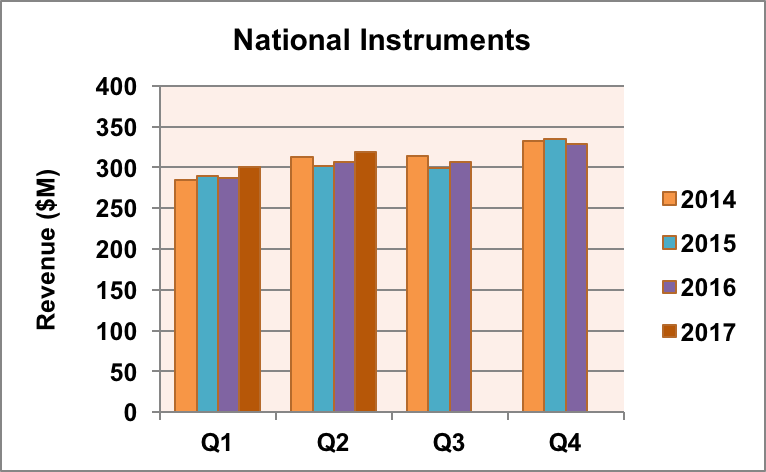After a fairly quiet few weeks, the news tempo has increased, with companies reporting financial results for the quarter ending around June 30.
Companies and Products
Apple shipped 41 million iPhones in their Q3, up 2 percent above the prior year’s quarter and down 19 percent from the prior quarter. Compared to the year-ago quarter, revenue increased 7 percent to $45.4 billion, and earnings per share grew 17 percent. Apple used $1.9 billion in cash, ending the quarter with $18.6 billion.


DSL Reports reported that Apple received an FCC license to test cellular link performance between base station transmitters and receivers at 28 and 39 GHz. In their application, Apple stated the tests “will provide engineering data relevant to the operation of devices on wireless carriers’ future 5G networks.”
Analog Devices (ADI) joined Mcity, a public-private partnership established to advance automated driving that is led by the University of Michigan. ADI will use the Mcity facility to test and refine future products in ADI’s Drive360 suite of technologies, including 28 nm CMOS radar, solid-state LiDAR and high performance inertial measurement units.
Comtech Xicom Technology received a $7.5 million follow-on order for GaN SSPAs for airborne, in-flight connectivity.
An icon of the point-to-point radio market, DragonWave entered receivership and faces liquidation.
Fujitsu reported achieving 4.5 W/mm power density with a GaN on SiC power amplifier operating at 94 GHz, which they claim is the world's highest power density at W-Band.
During their latest earnings call, IDT’s CEO Greg Waters disclosed the company is developing millimeter wave ICs and expects initial revenue from the products in 2018. Waters said this additional spectrum doubles their RF market size to more than $800 million. Listen to his comments.
Keysight Technologies announced a system for testing cellular and Wi-Fi simultaneously, from data traffic generation to physical transmission (layers 1 to 7). The T5510S Cellular + Wi-Fi Emulation System combines Keysight’s UXM network emulator with Ixia’s wave test system. Keysight acquired Ixia in April.
MACOM reported fiscal Q3 revenue of $195 million, reflecting growth of 37 percent year-over-year and 5 percent quarter-to-quarter. The networks segment contributed 77 percent of the quarter’s revenue, of which the optical and data center markets comprised 76 percent.

MACOM’s Q4 guidance reflects storm clouds from softness in China: at the midpoint of guidance, revenue is expected to decline approximately 13 percent from Q3. The stock market didn’t react favorably, with MACOM's stock price down 31 percent at week’s end.
During the earnings call, MACOM's CEO was asked about the status of qualifying their GaN on Si power transistors for base station power amplifiers. He noted more design ins and a critical customer audit scheduled this week. Listen to his comments.
National Instruments (NI) reported record Q2 revenue of $319 million, 4 percent above the prior year’s quarter. NI is targeting growth opportunities in 5G, semiconductor test, connected vehicle and the industrial IoT and noted that their RF business grew year-over-year.

Nokia’s Q2 revenue grew 1 percent year-over-year and 4 percent quarter-over-quarter to €5.6 billion ($6.6 billion). Revenue in the networks segment declined 5 percent year-over-year to €5.0 billion ($5.9 billion), reflecting the weak infrastructure market. Nokia forecasts the market will decline 3 to 5 percent this year.

Peregrine Semiconductor announced two executive appointments: Keith Bargroff was promoted to VP of engineering, and Sumit Tomar joined as VP of product marketing. Prior to joining Peregrine, Tomar was with MaxLinear and Qorvo.
Qorvo’s fiscal Q1 revenue came in at $641 million, which was flat with the prior quarter and 8 percent below the prior year’s quarter. The infrastructure and defense products (IDP) segment posted record revenue of $184 million, 22 percent above the year-ago quarter. The mobile products segment generated $456 million — 71 percent of the company’s total revenue — which was down 4 percent sequentially and down 17 percent year-over-year. Qorvo expects Q2 revenue to reach approximately $810 million, which reflects 26 percent sequential growth, although down 6 percent below the year-ago quarter.

Listen to excerpts from Qorvo’s earnings call, explaining what led to IDP’s record revenue.
WIN Semiconductors also achieved record quarterly revenue, reaching $126 million in Q2, up 16 percent sequentially and 7 percent above the year-ago quarter. Gross margin improved to 37 percent on increasing fab utilization, attributed to smartphone demand. WIN estimates demand will continue through Q3, yielding further revenue and margin increases.
Markets and Technology
Cellular — Addressing the need for mobile spectrum above the cellular bands and below millimeter wave, the FCC is seeking comments on allocating “mid-band” spectrum for broadband wireless applications. They identified the 3.7 to 4.2, 5.925 to 6.425 and 6.425 to 7.125 GHz bands and solicited suggestions of other frequencies between 3.7 and 24 GHz.
Even Ajit Pai, the FCC chair, is being spoofed by robocalls from familiar-looking numbers, the latest trick adopted to get you to answer your phone. Although the FCC is fining abusers, the best solution, according to Pai, is a new system that will authenticate callers.
Defense — Imagine doing EMC testing on a KC-46 tanker aircraft. Seems like quite a challenge, but it must be done.
Thoughts? Please share them by leaving a comment below.

